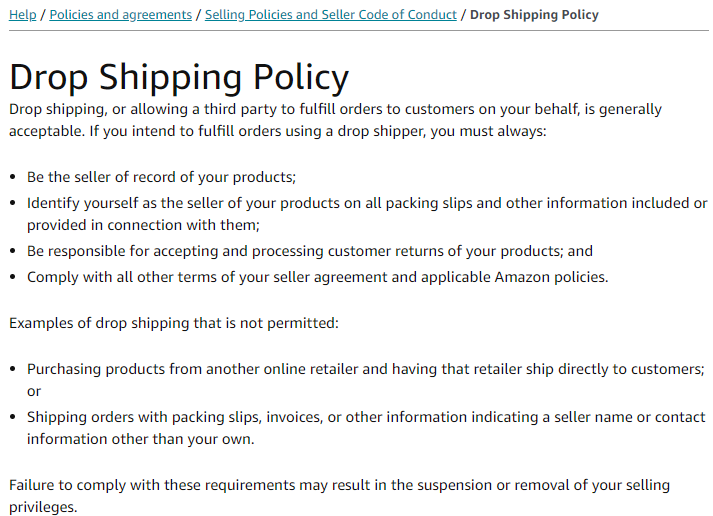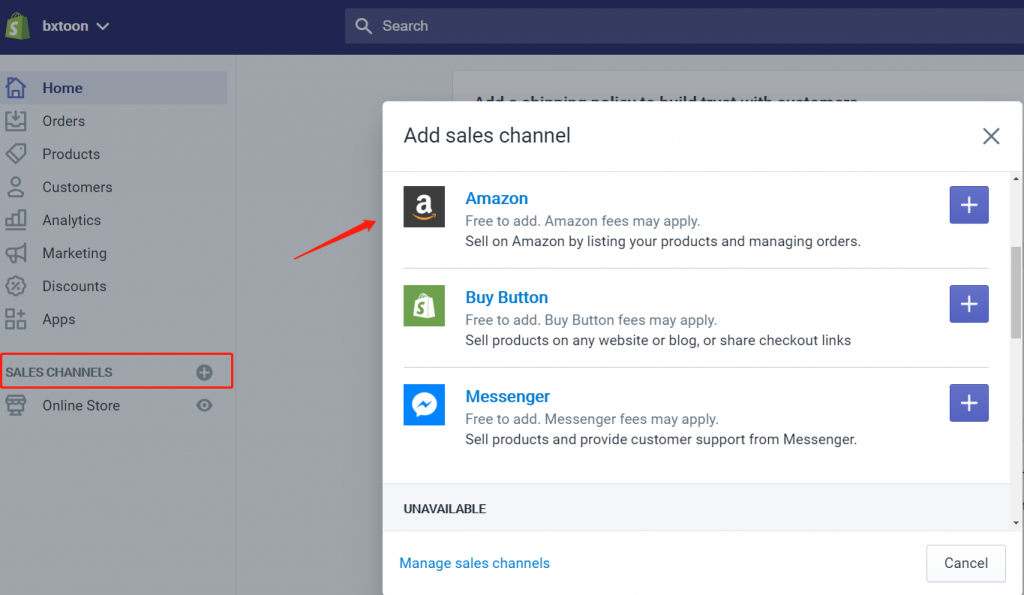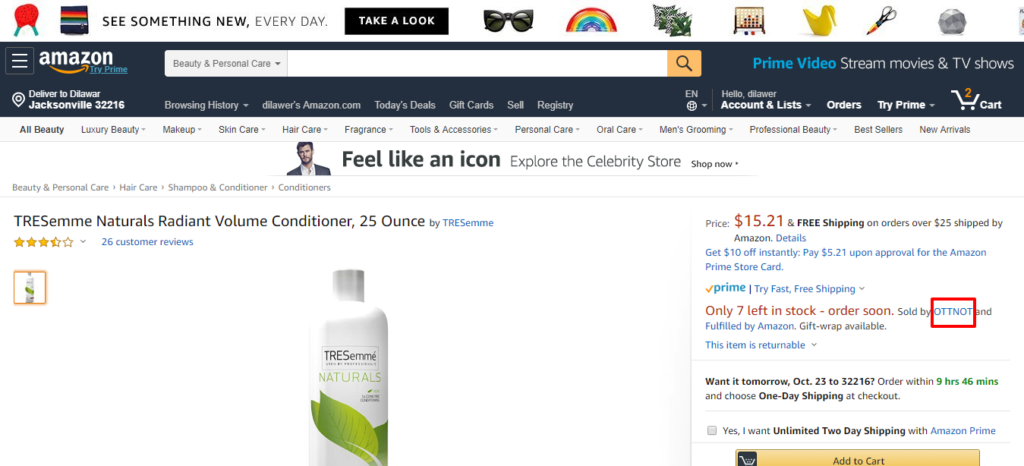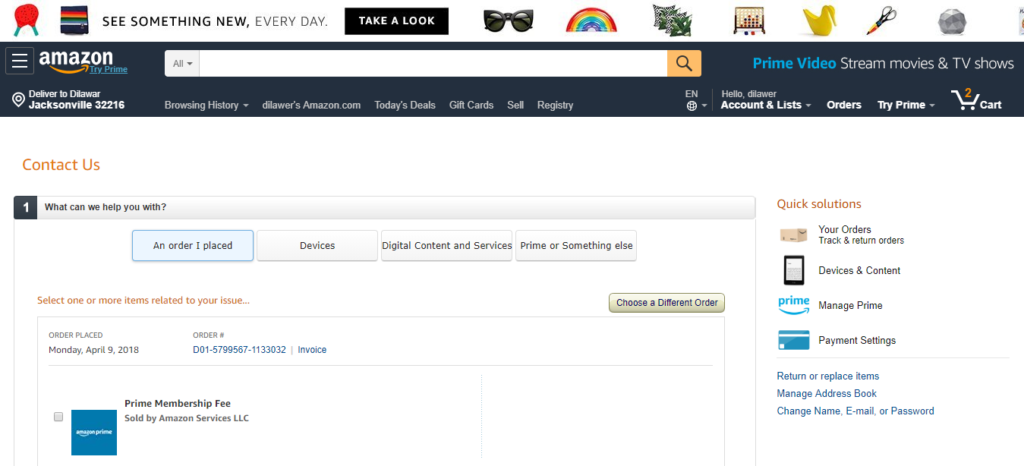Dropshipping on Amazon – Is it a Sustainable Business Model?
- Nov-11-2020
- Bilal Uddin
- 2 comments
After Shopify allows adding Amazon store to its sales channel, dropshipping on Amazon becomes much more comfortable.
Therefore, we have decided to prepare a wholesome guide about Dropshipping on Amazon.
Start Amazon Dropshipping 5 Easy Steps
1- Search for the perfect supplier
2- Create an account on Amazon
3- Agree with Amazon seller & dropshipping policies
4- Show yourself as the seller of the product (Integrate with Shopify)
5- Choose fulfillment by merchant (FBM)
But first, let’s understand this concept of dropshipping and Amazon dropshipping.
What is Dropshipping?
Dropshipping is an ecommerce business model in which the seller does not need stock the inventory. The seller displays the products and contacts the supplier for product sourcing. When the order is received on the seller’s eStores, it directs to the supplier and then the supplier delivers the product directly to the customer.

The seller lists the product at a markup price and earns a profit after deducing the product cost.
What is Amazon Dropshipping?
If you are not interested in Amazon FBA because of high upfront costs or a large stock of inventory, then you are going to love drop-shipping.
Amazon dropshipping allows the online retailer to sell the products to the customers of Amazon without keeping any inventory, bearing any cost of warehouses. The retailer can list the dropshipping products on Amazon, and when the order arrives, the supplier sends the product to the customer’s address.
So, if you ever wonder how to sell on Amazon without inventory, Amazon dropshipping is your answer.
However, there are some technicalities in this model. You should understand them in detail to make your Amazon dropshipping legal – and that leads to our next question!
Is Amazon Dropshipping Legal?
Yes, Amazon dropshipping legal. Amazon allows the dropshipping model, but it does not support it with open arms; there are some restrictions that you need to understand. Amazon does not allow the retailers to ship the product directly from another retailer (supplier) to the Amazon customer’s address. Amazon prefers that the retailer’s branding should be included in the packaging, invoice, and other information.
But, it is not such a big issue, you only need to contact the supplier and express your demands about products so only your name and information will be included in the products, not the suppliers. To understand these regulations in more detail, let’s look at Amazon dropshipping policy.
Amazon Dropshipping Policy
Amazon has a clear and straightforward policy for dropshippers. They have very strict rules for dropshipping businesses, and ignoring any single rule will get you in a lot of trouble with the ecommerce giant, which mainly includes getting your account banned from any further operations. So, you should always ensure that you are following the guidelines provided by Amazon for your dropshipping venture.
Below are the guidelines that Amazon has published for dropshipping on its platform.

The dropshipping that is not permitted on Amazon is when you purchase products from another supplier and have that supplier deliver the products for you – Which is actually a basic dropshipping model!
Related Article: 12 Bestselling Categories to Sell on Amazon
How to dropship on Amazon in 5 Steps
Here is the process you need to follow to get started dropshipping on Amazon
1- Search for the Supplier
The supplier is the uncrowned king of the dropshipping business.
Why?
Because the supplier has everything that you need to run an online business – Mainly the product and shipment!
So, you need to find a topnotch supplier who can deliver high-quality products and services. To pick the best supplier, you can use some paid services such as Jungle Scout. With the Jungle Scout Suppliers Database tool, you can check the Amazon supplier’s history and know how much product a single supplier has delivered to Amazon. Check out the detail Jungle scout review here.
You can choose from multiple dropshipping suppliers and check out their history in their stores. Aliexpress is considered as the top supplier for dropshipping products, and you can quickly validate the suppliers by just looking into its seller summary.
Check out this guide to learn how to validate the Aliexpress supplier.
Other than Aliexpress, numbers of dropshipper are out there who are excellent in providing dropshipping services, here are some of the top dropshipping suppliers
- Dropship Direct (Free to signup)
- Wholesale Central (Free to Signup)
- Salehoo ($67/yearly)
- Wholesae2B( $37.99/month to dropship on Amazon)
Want more suppliers?
Check out the list of 40+ Dropshipping Supplier.
Tip to Dropship on Amazon
However, here, we would like to recommend something. You should know that Amazon thrives on its fast delivery with its Prime shipping and even regular shipping being quite fast. So, customers don’t like it when you ship their orders after 2-3 weeks (which is quite normal when dropshipping from China). So, your best workaround is to work with local dropshipping suppliers from your region.
But you can make a deal with your Chinese supplier to make the shipment faster via USPS, although it charges fees, but if you negotiate well with your supplier and make a deal with them, the suppliers are pretty cool in lower down the prices.
2 – Create an Account on Amazon
Well, it is quite obvious, you need to become an Amazon seller to sell on this platform.
Amazon offers two accounts to become an Amazon seller,
Individual Account: There is no monthly fee of this account, although you can sell a maximum of 40 items/month and have access to 20 categories. There is a per-item fee of $0.99 that will be charged on every item sales.
Professional Account: There is a monthly subscription fee of $39.99, where you can sell more than 40 items monthly. A professional account holder can get into any category. However, some restricted categories can be accessed after approval.

If you want to learn in detail, check out this guide on how to become an Amazon Seller.
3- Read Amazon Seller & Dropshipping Policy
We have discussed Amazon dropshipping policy earlier. Let’s jump on to the Amazon seller policy.
Amazon seller policy mainly revolves around providing the right information, address customer’s issues attentively, and do not misuse any feature of Amazon features.
Check out the Amazon seller code of conduct here.
Amazon does not allow to sell some products on its platform. You can check out the list here.
Show yourself as the seller
Amazon does not permit to dropship any product that does not show you as the seller. In dropshipping, you do not manufacture and ship product, so there are a high risk that you leave any information about your supplier.
So, you’d better engage in a detailed conversation with your supplier and tell your requirement to add your information instead of the suppliers’.
4- Shopify Store Integration
The reason we prefer Amazon Dropshipping with Shopify is that Shopify semi-automates multiple dropshipping functions.

You can add a separate note to the suppliers when adding the product to your Shopify stores.

By adding a custom note, you can tell the supplier that you are dropshipping, so the supplier should not put any of his information in the packaging.
Learn how to set up a Shopify Dropshipping store.
5- Choose FBM (Fulfillment by Merchant)
In this fulfillment method, all the process of fulfillment has to be done by the merchant (you). The merchant is responsible for keeping the product, storage, packaging, and shipment.
But how is it possible in dropshipping?
It is possible. Your supplier will perform all these functions on behalf of you. Therefore, you do not need to pay any service fees to Amazon that you are liable in the case of the FBA program. You only need to have a good relationship and instant contact with your supplier to inform him about putting your information and branding on the package.
In this case, the merchant looks after all the fulfillment process. So it becomes hard for Amazon to know that the product is either being fulfilled by the merchant or the supplier.
With FBM, you have brighter chances to build your brand, have more control over everything, do not have to pay additional fees to Amazon, and changes in Amazon policies would not bother you much.
Is Amazon FBA Dropshipping Possible?
In the FBA program, the merchant needs to deliver the product to Amazon fulfillment centers. When a customer makes a purchase from your store, then Amazon picks up the products from their fulfillment center, does the packaging, and delivers it to the shipping address.
So, you have to deliver the product in bulk quantity to one spot; then Amazon takes care of your products. For its services, of keeping the stock, packaging, and shipment, Amazon charges some fees.
You need to ship the product in bulk quantities.
This model will fall under the private label products or retail arbitrage category, not dropshipping!
So, if you choose to sell from Amazon FBA, then it would not be called dropshipping.
Advantages and Disadvantages of Amazon Dropshipping
Let’s see what the benefits and disadvantages of dropshipping on Amazon are. We are going to list the pros and cons of Amazon drop shipping so you can see if it’s even worth the effort to dropship on this platform.
Dropshipping on Amazon – Pros
Here are the advantages of dropshipping on Amazon.
Large audience: This one is pretty obvious. Most people often struggle when trying to get traffic to their ecommerce websites. However, if you are selling on Amazon, then most of your traffic issues are taken care of by Amazon itself. Millions of people visit Amazon every day, which means you get millions of potential buyers and views on your products. If you were selling on your own website, then you would have to work on marketing yourself, but selling on Amazing provides you with free marketing from the ecommerce giant.
Easy to set up: Another problem that ecommerce entrepreneurs often face when starting their dropshipping business is the setup part. If you are looking to start your own business, then set it up can be a tough part if you are not technically savvy, however, Amazon makes these things quite easier for everyone. Even if you are a newbie, Amazon makes everything simple and straightforward when setting up shop on the platform. So, you don’t have to worry about getting a domain, setting up hosting, etc.
Dropshipping on Amazon – Cons
There are more disadvantages to dropshipping on Amazon than there are advantages. Here are some of the downsides of Amazon dropshipping.

Can not build a brand: This is a given when building a dropshipping business on Amazon. The brand will always be Amazon, no matter how many products you sell. As long as you are using Amazon for selling the products, then you are losing out on building a brand for yourself. If you build your own online store and dropship products on it, only then you will be able to create a brand around your business; otherwise, you will just be adding to Amazon’s brand authority.
No access to customer data: This is a big one. Amazon does not provide you any customer emails, so you can not build a list for email marketing at all. Amazon also tries to deter sellers from contacting the customers. Losing the ability to build an email list is a big blow to an online business, so this is one of the more severe downsides of Amazon dropshipping.
No control over your store: You are not in any control over your Amazon store. Amazon can terminate your account at the drop of a hat without any explanations at all. It doesn’t matter if you break a rule once or just come close to breaking it, Amazon can shut you down without providing you with any details, and your precious store will vanish from the world wide web with no traces.

No control over customer support: Amazon deals with all the customer complaints and issues through its official support channel. They never forward any customer queries to the seller except for a few queries. So, most of the time, you wouldn’t even know that customers have a problem with their order. Also, this leads to more refunds/returns since Amazon loves giving out refunds, especially when the products are sold by a third-party.
Low profits: This is true since Amazon provides you with a platform to sell, free marketing of products, and entire ecommerce infrastructure, they also take a deep bite out of your revenue. Even after you pay the monthly fees for Amazon Professional seller account, Amazon also takes around 15%-20% on each sale. So, your profits margins go down even further.
Dropshipping on Amazon Vs. Shopify – What’s better?
Without a single shadow of a doubt, Shopify is the best way to go about dropshipping. They provide you with a plethora of tools like Oberlo to make your dropshipping venture as smooth as possible, and there are no restrictions either. Also, Shopify doesn’t meddle in your affairs as long as you are not breaking any terms of service.
Shopify also allows you the ability to build your own brand, and you can even scale your business to create a full-fledged ecommerce business if dropshipping doesn’t sound as lucrative down the line.
Amazon, as already mentioned, puts all these restrictions on dropshippers and makes it really hard for entrepreneurs to do any dropshipping activity easily. You are better of using Amazon FBA for fulfillment and storage rather then dropshipping on the platform.
If you are really keen on starting a dropshipping business, then our personal recommendation would be to choose Shopify over Amazon and save yourself all the hassle of dealing with Amazon’s strict rules and guidelines. Their seller support is also quite bad compared to their customer support.
Check out our Shopify Vs. Amazon comparison.
Most articles on Amazon dropshipping are quite misleading regarding the procedures and the entire process. According to Amazon’s dropshipping policy, a seller can not dropship from another online retailer such as Oberlo, which means you can’t use a tool like Oberlo to import products and dropship them on Amazon. So you are better off putting your effort into building your own dropshipping store (or starting an Amazon FBA business).
Wrapping up
Hopefully, this article helped out in some way. We know most have heard about doing dropshipping with Amazon FBA, but in the actual definition, it is not dropshipping. We apologize for bursting your beautiful bubble. However, this is the truth, even if you don’t like it.
But the main question that arises here is; Is Amazon dropshipping a sustainable model?
In our opinion, no, it is not a sustainable business!
We have seen countless newcomers burn themselves out by trying to comply with Amazon’s rules while dropshipping on the platform only to end up with a fistful of nothing. Also, Amazon’s policies are very complicating for a newbie to follow it impeccably.
You might see that one person doing really-well drop-shipping hundreds of products on Amazon, but that’s not a sustainable business in the long run. They will never be able to build a brand around their business, and one slip-up could lead to the demise of their so-called business.
So, you are better off starting your own dropshipping business with your own online store like Shopify, which is sustainable and easy to scale in the future and sync it with Amazon to increase your target audience.
If you learned something from this post, then please leave a comment letting us know what you think. Even if you don’t agree with the post, we’d like to hear your thoughts on the subject and how you’d go about dropshipping on Amazon.

 How to Chargeback on PayPal to Get Your Money Back
How to Chargeback on PayPal to Get Your Money Back  What to Sell on Etsy –12 Best Selling Items on Etsy in 2021
What to Sell on Etsy –12 Best Selling Items on Etsy in 2021  11 Easy Ways to Make Money on Amazon in 2021
11 Easy Ways to Make Money on Amazon in 2021  eBay Dropshipping – Learn Dropshipping on eBay in 5 Steps
eBay Dropshipping – Learn Dropshipping on eBay in 5 Steps
Thank you. Very helpful!
I think selling online is the easiest way to make money online, of course, it will take time but it will work for sure as long as you put the effort into your business.